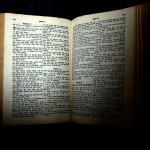Of course, much of this [i.e., that Israel worshiped El and Asherah alongside YHWH] is really to be expected given that recent syntheses of the archaeological, cultural, and literary data pertaining to the emergence of the nation of Israel in the Levant show that most of the people who would eventually compose this group were originally Canaanite. As the Hebrew Bible notes, the Hebrew language itself is a Canaanite language, literally the “lip of Canaan” (שְׂפַת כְּנַעַן; Is. 19:18), and so it cannot often be distinguished by modern scholars from other Canaanite inscriptions on purely linguistic grounds.[1] Moreover, during the Late Bronze and Early Iron I periods both “linear and cuneiform alphabetic scripts are attested in inscriptions in the highlands as well as in the valleys and on the coast.”[2] Furthermore, specific technical religious terminology for cult sacrifices and personnel in Israelite religion often have exact correspondents in Ugaritic and Phoenician.[3] Further, Israelite material culture is extremely difficult, if not impossible, to distinguish from Canaanite material culture in the Late Bronze and early Iron I periods.[4] Rather, it shows direct continuity with the preceding ages and cultures in such features as collar-rim jars, four-room house architecture, cisterns, and burial patterns.[5] Archeologists have tried to provide a clear set of criteria in order to distinguish between Israelite and Canaanite sites in the earliest periods, but often with little success (though not for lack of trying). Additionally, the texts of the Hebrew Bible, although admittedly written hundreds of years after the events they purport to record, complicate matters by further noting the existence of many other foreign groups in the land (e.g., Ex. 6:15; Josh. 3:10; 9:15; 14:13-14; Judges. 1:16; 1 Sam. 27:10). Finally, archaeology has in many cases persuasively undermined the Conquest Model of Israel’s entrance into the land of Canaan, a model mostly dependent upon the narrative found in the book of Joshua.[6] Marc Brettler has summarized well the issues and problems. I quote him at length:
Someone conquered some of the cities that the Bible claims Joshua conquered[, but] it is difficult to discern who conquered them (we know that the Sea People, including the Philistines, were also settling the area at this time and taking over population centers)[.] One reason that the conquerors’ identity is obscure is because Israelite artifacts are practically the same as those of other local groups living at this time; [and] of the cities that according to Joshua were conquered in the period, archaeological evidence for many of these sites show no signs of conquest[. T]his period meanwhile shows a remarkable upsurge of new settlement in the central hill or highland area of the country. . .What would the archaeological record look like if the Book of Joshua were factual? We would expect to find a complete destruction of the major Canaanite cities datable to the same time period. In addition, we would expect to find Canaanite material culture (pottery jugs, housing styles) replaced by totally new styles, most likely with Egyptian motifs or styles, reflecting the origins of the conquering people. However, such evidence eludes us even after a large number of excavations and surveys (mini-excavations). What have archeologists found instead? Some evidence of destruction, but significantly more evidence for new settlement patterns at previously uninhabited sites in the highlands. This suggests to many that the main claim in Joshua—a complete and total conquest by Israel—is false; rather many Israelites originated as Canaanites. Archeologists in general now doubt that the people Israel arose predominately outside the land of Israel.[7]
Thus it seems that Ezekiel was right after all when he stated, “Thus says my Lord, YHWH, to Jerusalem: your origin and your birthplace are of the land of the Canaanites, your father an Amorite, your mother a Hittite” (כֹּה־אָמַר אֲדֹנָי יְהוִה לִירוּשָׁלִַם מְכֹרֹתַיִךְ וּמֹלְדֹתַיִךְ מֵאֶרֶץ הַֽכְּנַעֲנִי אָבִיךְ הָאֱמֹרִי וְאִמֵּךְ חִתִּֽית; Ezek. 16:3). In contrast to the later historiographical picture given in much of the Hebrew Bible, worship of El, Asherah, and other divinities was not a matter of Israelites adopting foreign cults and practices into their own YHWHistic religion—that is, it was not a syncretistic process—but rather it was a matter of continuing ancient, traditional practices inherited from Israel’s own Canaanite heritage. I conclude, therefore, with Mark Smith that:
. . . the evidence that the Canaanite deities, El, Baal, or Asherah, were the object of Israelite religious devotion separate from the cult of Yahweh in the period of the Judges is scant. Both of these claims are largely extensions of biblical historiography. . . However, in various ways, El, Baal, and Asherah (or at least the symbol named after her, the asherah), were integrally related to Yahweh and the cult of this deity during the period of the Judges.[8]
[1] For this and the following points, see Smith, The Early History of God, 6-7, 19-25, 27, 31.
[2] See Smith, The Early History of God, 20, and the literature cited there. See also Frank Moore Cross, Leaves from an Epigrapher’s Notebook: Collected Papers in Hebrew and West Semitic Palaeography and Epigraphy. Harvard Semitic studies, no. 51 (Winona Lake: Eisenbrauns, 2003); and J. Naveh, “The Scripts in Palestine and Transjordan in the Iron Age,” Near Eastern Archaeology in the Twentieth Century (ed. by Nelson Glueck and James A. Sanders; Garden City: Doubleday, 1970), 277-283.
[3] Smith, The Early History of God, 22-24. For a detailed analysis of cult, ritual, and ritual texts at Ugarit, see Pardee, Ritual and Cult at Ugarit.
[4] Smith, The Early History of God, 6-7, 21, 27. For a mainstream introduction to issues pertaining to the archaeology of ancient Israel, see William Dever, Who Were the Early Israelites, and Where Did They Come from? (Grand Rapids: Eerdmans, 2003). See also James Maxwell Miller and John Haralson Hayes, A History of Ancient Israel and Judah (Louisville: Westminster John Knox Press, 2006).
[5] Some scholars argue, however, that some of these features, such as four-room house architecture, are distinctive of Israelite sites. See, for example, Dever, Who Were the Early Israelites, and Where Did They Come from?, 102-107.
[6] See Miller and Hayes, A History of Ancient Israel and Judah; and Dever, Who Were the Early Israelites, and Where Did They Come from?
[7] Marc Zvi Brettler, How to Read the Jewish Bible (New York: Oxford University Press, 2007), 95-96.
[8] Smith, The Early History of God, 31.











